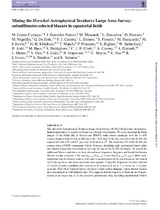| dc.contributor.author | Lopez-Caniego, M. | |
| dc.contributor.author | Gonzalez-Nuevo, J. | |
| dc.contributor.author | Massardi, M. | |
| dc.contributor.author | Jarvis, Matt | |
| dc.date.accessioned | 2018-01-11T13:53:28Z | |
| dc.date.available | 2018-01-11T13:53:28Z | |
| dc.date.issued | 2013 | |
| dc.identifier.citation | Lopez-Caniego, M. et al. (2013). Mining the Herschel-Astrophysical Terahertz Large Area Survey: submillimetre-selected blazars in equatorial fields. Monthly Notices of the Royal Astronomical Society, 430: 1566 - 1577 | en_US |
| dc.identifier.issn | 0035-8711 | |
| dc.identifier.uri | http://dx.doi.org/10.1093/mnras/sts680 | |
| dc.identifier.uri | http://hdl.handle.net/10566/3383 | |
| dc.description.abstract | The Herschel-Astrophysical Terahertz Large Area Survey (H-ATLAS) provides an unprecedented
opportunity to search for blazars at sub-mm wavelengths. We cross-matched the Faint
Images of the Radio Sky at Twenty-cm (FIRST) radio source catalogue with the 11 655
sources brighter than 35 mJy at 500 μm in the ∼135 deg2 of the sky covered by the H-ATLAS
equatorial fields at 9h and 15h, plus half of the field at 12h.We found that 379 of the H-ATLAS
sources have a FIRST counterpart within 10 arcsec, including eight catalogued blazars (plus
one known blazar that was found at the edge of one of the H-ATLAS maps). To search for
additional blazar candidates we have devised new diagnostic diagrams and found that known
blazars occupy a region of the log(S500μm/S350μm) versus log(S500μm/S1.4 GHz) plane separated
from that of sub-mm sources with radio emission powered by star formation, but shared
with radio galaxies and steep-spectrum radio quasars. Using this diagnostic we have selected
12 further possible candidates that turn out to be scattered in the (r − z) versus (u − r) plane
or in the Wide-Field Infrared Survey Explorer colour–colour diagram, where known blazars
are concentrated in well defined strips. | en_US |
| dc.language.iso | en | en_US |
| dc.publisher | Oxford University Press | en_US |
| dc.rights | http://dx.doi.org/10.1093/mnras/sts680 | |
| dc.subject | BL Lacertae objects | en_US |
| dc.subject | Quasars | en_US |
| dc.subject | Submillimetre | en_US |
| dc.title | Mining the Herschel-Astrophysical Terahertz Large Area Survey: submillimetre-selected blazars in equatorial fields | en_US |
| dc.type | Article | en_US |
| dc.privacy.showsubmitter | FALSE | |
| dc.status.ispeerreviewed | TRUE | |

